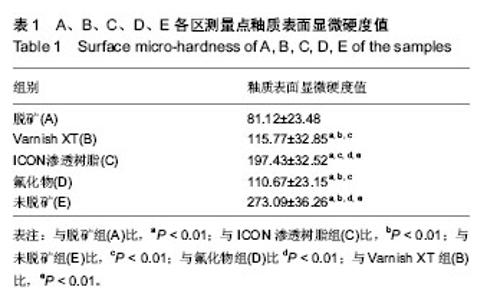| [1] Torres CR, Borges AB, Torres LM, et al. Effect of caries infiltration technique and fluoride therapy on the colour masking of white spot lesions. J Dent. 2011;39(3):202-207.
[2] Ekstrand KR, Bakhshandeh A, Martignon S. Treatment of proximal superficial caries lesions on primary molar teeth with resin infiltration and fluoride varnish versus fluoride varnish only: efficacy after 1 year. Caries Res. 2010;44(1):41-46.
[3] Calvo AFB, Tabchoury CPM, Del Bel Cury AA, et al. Effect of acidulated phosphate fluoride gel application time on enamel demineralization of deciduous and permanent teeth. Caries Res. 2012;46(1):31-37.
[4] Fong H, Dickens SH, Flaim GM. Evaluation of dental restorative composites con-taining polyhedral oligomeric silsesquioxane methacrylate. Dent Mater. 2005;21(6): 520-529.
[5] Shajii L, Santerre JP. Effect of filler content on the profile of released biodegradation products in micro-filled bis-GMA/ TEGDMA dental composite resins. Biomaterials. 1999; 20(2):1897-1908.
[6] Ana PA, Tabchoury CP, Cury JA, et al. Effect of Er,Cr:YSGG laser and professional fluoride application on enamel demineralization and on fluoride retention. Caries Res. 2012; 46(5):441-451.
[7] Wegehaupt FJ, Taubock TT, Stillhard A, et al. Influence of extra-and intra-oral application of CPP-ACP andfluoride on re-hardening of eroded enamel. Acta Odontologica Scandinavica. 2012;70(3):177-183.
[8] Herkstroter FM, Witjes M, Rub en J, et al. Time dependency of microhardness indentations in human enamel. Caries Res. 1989;23(5):342.
[9] Haroula KK, Eleni MH, Iliana D. An in vitro study of the effect of aluminum and the combined effect of strontium, aluminum, and fluoride elements on early enamel carious lesions. Biol Trace Elem Res. 2012;147(1-3):418-427.
[10] Sun LL, Liang SS, Sa Y, et al. Surface alteration of human tooth enamel subjected to acidicand neutral 30% hydrogen peroxide. J Dent. 2011;39(10):686-692.
[11] Paris S, Meyer-Lueckel H, Mueller J. Progression of sealed initial bovine enamel lesions under demineralizing conditions in vitro. Caries Res. 2006;40(2):124-129.
[12] 郑铁丽,黄翠,张智星,等.离体牙储存方式对牙本质黏结剂微拉伸强度的影响[J].上海口腔医学,2005,14(2):147-150.
[13] 石旭旭,常靓,邹高峰,等.金属基底冠边缘的适合性:2种制作方法比较[J].中国组织工程研究,2014,18(25):4014-4019.
[14] 刘烨,陈溯,张振庭.含氟酪蛋白磷酸肽-磷酸钙复合物对牙齿耐磨性的影响[J].北京口腔医学,2012,20(2):74-76.
[15] 王冠华,李燕妮,姚晖,等.OCT检测人离体牙根部早期脱矿的实验研究[J].医学研究杂志,2010,39(9):36-39.
[16] 隋小玲,刘源,杨燃,等.奥乐V护牙剂对早期釉质龋再矿化作用的研究[J].华西口腔医学杂志,2013,31(2):141-144, 149.
[17] Wiegand A, Stawarczyk B, Kolakovic M, et al. Adhesive performance of a caries infiltrant on sound and demineralised enamel. J Dent. 2010;39(2):117-121.
[18] Gray GB, Shellis P. Infiltration of resin into white spot carieslike lesions of enamel: an in vitrostudy. Eur J Prosthodont Restor Dent. 2002;10(1):27-32.
[19] 范旭升,李志华,石慧,等.模拟口腔环境下温控型镍钛弓丝力学性能的实验研究[J].华西口腔医学杂志,2012,30(2):217-220.
[20] 李盛楠,李晓婷,马超,等.正畸患者龋齿发生倾向及其预防方法研究进展[J].中华临床医师杂志,2013,7(4):1706-1708.
[21] Lovror S, Hertrich K, Hirschfelder U. Enamel demineralization during fixed orthodontic treatment-incidence and correlation to various oral-hygiene parameters. J Orofac Orthop. 2007; 68(5):353-363.
[22] Leeuw NH. Resisting the onset of hydroxyapatite dissolution through the incorporation of fluoride. J Phys Chem. 2003; 108(6):1809-1811.
[23] 朱昞,李继遥,郝玉庆,等.口腔生物膜动态研究模型的建立和应用评价[J].上海口腔医学,2010,19(1):60-65.
[24] 楚金普,周学东.人牙与牛牙用于人工龋损实验的比较病理学观察[J].实验动物与比较医学,2014,34(3):176-180.
[25] Paris S, Schwendicke F, Sedding S, et al. Micro-hardness and mineral loss of enamel lesions after infiltration with various resins: influence infiltrant composition and ap-plication frequency in vitro. J Dent. 2013;41(6):543-548.
[26] 刘建华,胡征,韩继双,等.渗透树脂对早期龋齿的渗透研究[J].成都医学院学报,2012, 7(2):264-265.
[27] Amaral CM, Castro AKBB, Pimenta LAF, et al. Effect of techniques of composite resin insertion and polymerization on microleakage and microhardness. Pesqui Odontol Bras. 2002; 16(3):257-262.
[28] Souza ROA, Ozcan M, Michida SMA, et al. Conversion degree of indirect resin composites and effect of thermocycling on their physical properties. J Prosthodont. 2010;19(3):218-225.
[29] Ten CJ. Current concepts on the theories of the mechanism of action of fluoride. Acta Odontol Scand. 1999;57(6):325-329.
[30] Kutsch VK, Chaiyabutr Y, Milicich G. Reconsidering remineralization strategies to include nanoparticle hydroxyapatite. Compend Contin Educ Dent. 2013;34(3): 170-177.
[31] Mei ML, Chu CH, Low KH, et al. Caries arresting effect of silver diamine fluoride on dentine carious lesion with S. mutans and L. acidophilus dual-species cariogenic biofilm. Med Oral Patol Oral Cir Bucal. 2013;18(6):e824-831.
[32] Mohammed NR, Kent NW, Lynch RJ, et al. Effects of fluoride on in vitro enamel demineralization analyzed by ¹?F MAS-NMR. Caries Res. 2013;47(5):421-428.
[33] Loskill P, Zeitz C, Grandthyll S, et al. Reduced adhesion of oral bacteria on hydroxyapatite by fluoride treatment. Langmuir. 2013;29(18):5528-5533.
[34] Liu Y, Hsu CY, Teo CM, et al. Potential mechanism for the laser-fluoride effect on enamel demineralization. J Dent Res. 2013;92(1):71-75.
[35] Hariri I, Sadr A, Nakashima S, et al. Estimation of the enamel and dentin mineral content from the refractive index. Caries Res. 2013;47(1):18-26.
[36] Lippert F. Dose-response effects of zinc and fluoride on caries lesion remineralization. Caries Res. 2012;46(1):62-68.
[37] Lippert F, Butler A, Lynch RJ, et al. Effect of fluoride, lesion baseline severity and mineral distribution on lesion progression. Caries Res. 2012;46(1):23-30.
[38] Shiiya T, Mukai Y, Ten Cate JM, et al. The caries-reducing benefit of fluoride-release from dental restorative materials continues after fluoride-release has ended. Acta Odontol Scand. 2012;70(1):15-20.
[39] Tschoppe P, Meyer-Lueckel H. Mineral distribution of artificial dentinal caries lesions after treatment with fluoride agents in combination with saliva substitutes. Arch Oral Biol. 2011;56(8): 775-784.
[40] Najibfard K, Ramalingam K, Chedjieu I, et al. Remineralization of early caries by a nano-hydroxyapatite dentifrice. J Clin Dent. 2011;22(5):139-143.
[41] Poggio C, Lombardini M, Colombo M, et al. Impact of two toothpastes on repairing enamel erosion produced by a soft drink: an AFM in vitro study. J Dent. 2010;38(11):868-874.
[42] 赵晓一,高学军.渗透树脂治疗对釉质白斑样病损颜色的影响[J].华西口腔医学杂志,2014,32(3):306-309.
[43] 赵晓一,高学军.渗透树脂治疗对人工釉质龋表面微硬度影响的研究[J].牙体牙髓牙周病学杂志,2014,24(8):455-458. |

